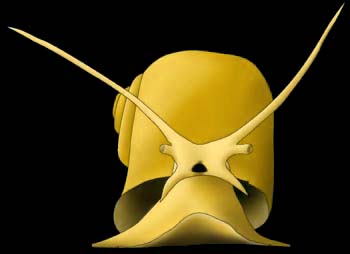
| Apple Snails (Genus Pomacea)(*1) |
The apple snail is a tropical freshwater snail
that belongs to the genus Pomacea (family Pilidae or Ampullariidae)(*2).
The different species are all found in the New World (South America, Central America, the
West Indies and the Southern U.S.A.).
In 1984, they were discovered in Thailand, where they were illegally introduced by
tropical fish farmers to clean the tanks. From then on the apple snails rapidly spreaded
over South Asia and became a pest for the environment and a threat for the rice
production.
They are a popular aquarium-snail over the whole world because of their attractive
appearance and they are even cultured in farms as raw materials for canned food because
they have a palatable food muscle.
When taken good care over, the apple snail can reach a large size (15cm or 6 inch
diameter).
Apple snails are moderately amphibious. They have a branchial respiration system (right
side of their body) to breathe under water as well al lung (left side of the body) to
respirate air. The apple snails can form a tubular siphon on their left side to breathe
air, while they are still below the water surface.
The apple snail can be found in ponds, swamps and rivers and although they sometimes leave
the water, they spend most of their time in water.
Apple snails have separated sexes (gonochoristic). They are not hermaphrodite like many people think. In fact most snails from the genus Pomacea have separated sexes. However, at least the snails from the species canaliculata (golden apple snail) are able to change their sex from male to female.
When the snails mate, the male snail approaches the female from behind and creeps on her shell. Once he has reached the front of her shell, he rapidly (within a fraction of a second) puts his penis in her. With this action the mating ceremony has started and the snails stay in this position for about an hour after which the snails separate again and continue their daily life.
When the time has come for the female snail to deposit her eggs, she climbs out of the
water during the night. Approximately 5 till 20centimeters above the waterline she
deposits her eggs one by one. The process of laying the eggs can take hours, every 30
seconds an egg comes out of her shell and is guided over her body towards the other
eggs. The number of eggs can vary from 100 to 1000 and they have a calcareous shell
to protect them from drying out. The eggs can be laid in two days; the first part is laid
on the first day and the other half on the second day.
After a week or six (depending on the temperature) the young snails have eaten all the
intermediate eggshells so that the egg-clutch is completely hollow. Finally the young
snails eat their way out of the clutch and head for the water.
The reproduction rate of the apple snails depends on the temperature of their environment
and the available amount of food.
Note 1, 2003:
Not only the genus Pomacea, but the whole family can be considered to
be 'apple' snails.
Note 2: The name Pilidae is invalid.
[Introduction] [Food/reproduction] [Anatomy] [FAQ] [Photographs] [Links] [Design]
(c) 1998 by Stijn Ghesquiere
All rights reserved.